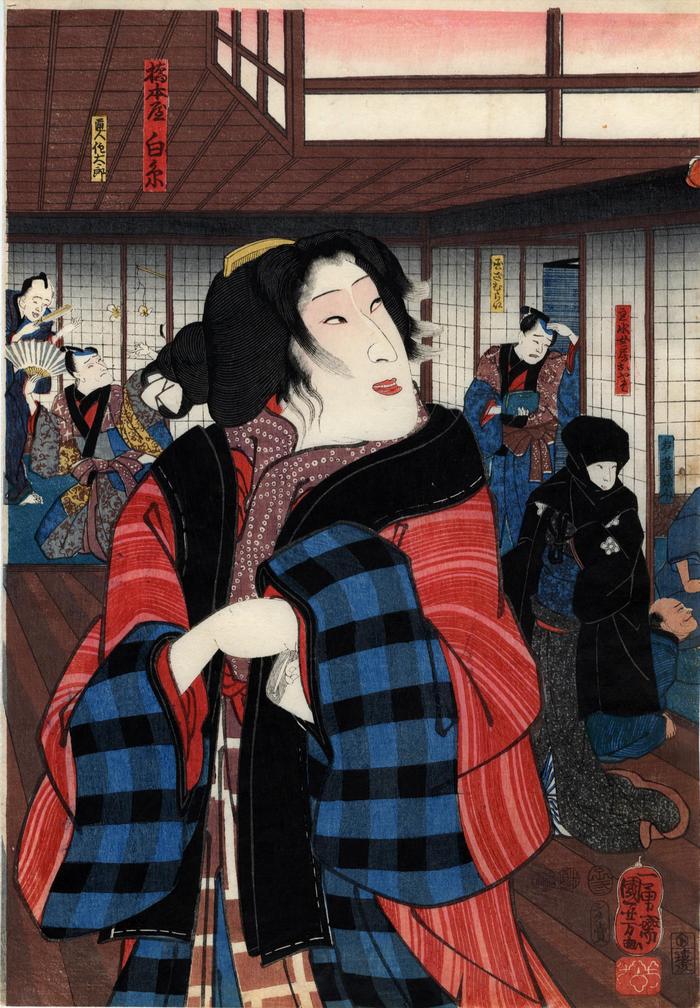Utagawa Kuniyoshi (歌川国芳) (artist 11/15/1797 – 03/05/1861)
Bandō Shūka I as the courtesan Shiraito (白糸) of the Hashimotoya (橋本屋) - this is the left-hand panel of a diptych
03/1852
9.75 in x 14 in (Overall dimensions) Japanese color woodblock print
Signed: Ichiyūsai Kuniyoshi ga
一勇斎国芳画
Seal: kiri
Publisher: Enshūya Hikobei
(Marks 055 - seal 21-016)
Censor seals: Mera and Watanabe
Date seal: 3/1852
Seal: shita-uri or 'discreet sale' (シタ売)
Art Gallery of New South Wales - the full diptych
National Museums Scotland
Kunitachi College of Music Library (via Ritsumeikan University)
Honolulu Museum of Art - Yoshitoshi 1886 diptych of Shiraito
Museum of Fine Arts, Boston - 1852 Kunisada triptych of Suzuki Mondo, Shiraito and Oyaso
Lyon Collection - 1852 Kunisada print of Suzuki Mondo
Los Angeles County Museum of Art - a similar Kuniyoshi portrait of Bandō Shūka I portrait of Shiraito - from the same performance
Victoria and Albert Museum This print commemorates a scene from the play Sumidagawa tsui no kagamon (隅田川対高賀紋) performed in 2/1852 at the Nakamura (or Ichimura) Theater in Edo.
Note the Western style perspective.
****
"By far the most popular kudoki was 'Suzuki Mondo,' the story of a faineant samurai who squanders all his money on the geisha Shiraito, thereby bringing about the ruin of his house and family... The incident on which the story is based may have occurred in Edo in 1801, although some scholars believe that Shiraito may not have existed at all."
Quoted from: The Autobiography of Takahashi Chikuzan: Adventures of a Tsugaru-jamisen Musician, p. xi.
Kabuki21 defines kudoki (口説き) as "highly dramatic scene in which an onnagata actor depicts a woman's sighs, tears, love, passion or regrets for the past. Somehow the equivalent of an aria for Kabuki female roles."
****
The figure in the background in the black cape with hood is Suzuki Mondo's wife in disguise as a man. She has come to confront and possibly try to kill Shiraito. This is based on the information provided from a Yoshitoshi diptych of this scene.
****
The term shita-uri as a special meaning according to Sarah Thompson in Undercurrents in the Floating World: Censorship and Japanese Prints in describing a multi-panel composition on pages 52-53: "A further concession to the reform laws, the print bears a special seal on each sheet reading shitauri, or "selling below," indicating that it could be sold only from the counter and not hung up for display at the front of the store."
Enshūya Hikobei (遠州屋彦兵衛) (publisher)
Bandō Shūka I (初代坂東しうか: from 11/1839 to 11/1854) (actor)
actor prints (yakusha-e - 役者絵) (genre)
Kabuki (歌舞伎) theater terms (genre)
